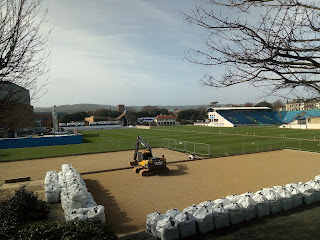This was just an amazing outing … to what is now a private
residence ...
 |
| The King's Observatory southern entrance (on a coolish autumn day) |
... but the hunting grounds were still in existence surrounding the remains of the Carthusian Monastery, built on the orders of Henry V in 1414.
 |
| A model of Richmond Palace ... only vestigial traces remain - notably the Gate House, which I walked through on my way home |
King George III (1738 – 1820), who had always been fascinated with the science of his time, used to visit Richmond Lodge, his country retreat ...
 |
| The telescope cupola seen from the roof |
... it was here that he would construct an observatory … to view the heavens and, in particular, the 1769 Transit of Venus.
 |
| An image of the sun captured in the last Transit of Venus 2012 ... Venus is the black dot upper right |
This rare astronomical event permitted scientists to gain the first realistic estimates of the size of the Solar System and the distance between Earth and Sun.
 |
| Account of George III's observations |
King George, his wife, Queen Charlotte and guests were in attendance, thenceforth the King regularly used the Observatory for various purposes, storing of his instruments, educating his children … while staying at the Lodge.
 |
| The River Thames loops round Richmond Park |
The architect, Sir William Chambers (1723 - 1796), completed the building, raising it above the floodplain, with its first entrance from the north side near the River Thames … the waterway connecting early royal residences - Greenwich, the Tower of London, Whitehall, Richmond and on to Windsor.
 |
| the grounds are now part of a golf course - so have significantly changed. |
Sir William also loved Chinese landscape and had on a few occasions travelled to Canton to study it more thoroughly … which he then incorporated into the more formal Italianate style of the parkland at that time. He was responsible for the recently renovated famous ten storey Kew Pagoda in Kew Gardens nearby …
… this put him at odds with Lancelot Brown, the ‘great English 18th century gardener’ known as ‘Capability Brown’ who favoured open parkland.
 |
| The magnetic huts, seen here across the lawn, have been moved and are now together |
 |
| Looking down from the roof |
It was then leased as a commercial office building in 1981 … the lessees didn’t give the building much respect … but thankfully in 2011 permission was requested to change the use of the building to residential, which was granted in 2014.
 |
| Not the original telescope |
The present owner has restored and renovated this incredible building to Grade 1 building standards, including its telescope cupola, which opened for private tours in 2019 when I was able to visit. Thank goodness I went … I so enjoyed it.
Also getting the tube across from Victoria Station,
rather than travelling by barge, or taking a horse and cart from central London
is considerably easier and quicker!
 |
| Custom built library table, with this beautiful carpet |
The building contains pairs of connected octagonal
rooms … this has been painstakenly highlighted using this superb carpet under
the equally special library table.
 |
| Looking through from the library to the dining room |
The glass cabinets in the original construction were
used to house the king’s ‘treasures’ – which are now safely stored in
appropriate scientific institutions in London.
 |
| The restored glass cabinets |
When the cabinets (they are also Grade 1 listed status) were stripped back for restoration and repainting – it was found there were 18 layers of paint … the first colour has been faithfully reproduced (the duck egg blue as seen looking through from the library to the dining room in the photo above).
The early Prime Meridian at Kew goes through the drawing room … and then was used to co-ordinate triangulation points for the official meridian (0 degrees Longitude) at Greenwich (Greenwich Mean Time - the mean solar time at the Observatory in east London at Greenwich).
The “magnetic huts” erected in 1854 and 1912 contain no metallic nails and were used for scientific experiments … while in WWII weather balloons were dispatched from them to check the winds in the upper stratosphere.
 |
| One wall - the rest of the walls are covered in a series of panoramic views |
The traditional hand painted silk wallpaper of a Canton
River Scene, depicted the foreign factories in China, c 1772, being roughly the
same age as the Observatory.
Fromental make these hand painted silk wallcoverings
in the long-established Chinese painting style using traditional materials.
 |
| Another Fromental scene, incorporating the porthole window of the original building |
This delicate wallpaper took over 4,300 hours (getting on for six months) of hand painting the fine details in Chinese water colours onto silk, that is then mounted onto traditional rice paper backing before the final more European elements, such as the clouds and western figures, were add by a UK based artist.
I still cannot believe I was able to walk and wander
around this amazing home – led by the owner, who was a fount of knowledge with
impeccable style. I could have spent hours talking to him.
 |
| Walking back to the tube and home ... |
It was a wonderful outing and then I had an autumnal walk back to the river before finding my way to the station and eventually home.
The King’s Observatory official site – with full
details, photos and its history …
Hilary Melton-Butcher
Positive Letters Inspirational Stories




























